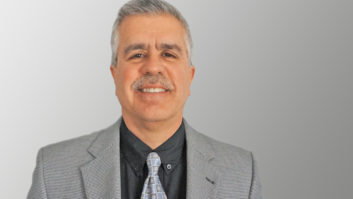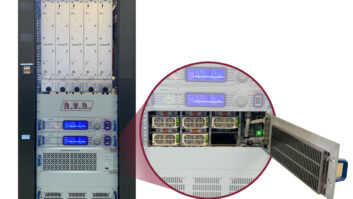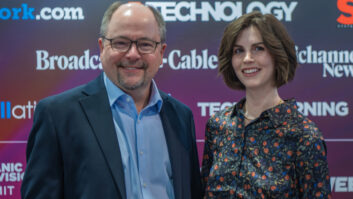Several future capabilities of HD Radio were demoed by Ibiquity Digital vendors on the show floor at NAB2007. These included conditional access, real-time traffic, time shifting, Electronic Program Guide and record and rewind functions.
Ibiquity and its partners are vetting these concepts and hope to commercialize several soon, said Scott Stull, vice president of broadcast business development.
NDS Unveils Conditional Access Details
Several companies demoed conditional access, the ability to encrypt an HD Radio signal and then permit or deny the receiver the ability to decode the signal.
This would bring a function that is already available in satellite radios to the terrestrial radio realm.
HD Radios will soon be addressable by channel and time of day. Ibiquity executives said NDS conditional access technology will be built into all new HD Radios starting in the fourth quarter of this year. Developer NDS received a Radio World “Cool Stuff” Award for the concept. NDS also announced planned pricing of its equipment.
NDS showed its RadioGuard system. Director of U.S. Data Applications Delivery for RadioGuard Tom Rucktenwald told attendees of a multicasting panel, “We’re only talking about encrypting the multicast channel. The main HD-R channel would always be free.”
At the show, NDS revealed that it would oversee a national receiver database needed for receiver entitlements. Each HD Radio would carry a unique ID number. The “HD Radio Global Service Registry” would be handled by NDS Israel, along with encryption and decryption.
The registry would be available to broadcasters and service providers, said Jordan Scott, director of advanced application services for Ibiquity.
NDA Americas would be responsible for entitlement, serialization and customer support testing.
If someone tries to access an encrypted channel, the receiver display would state “service not authorized” and the user would see a call to action, such as the Web site address of the station, to find out more.
Prototype NDS equipment and modified receivers were displayed. Ibiquity needs to add a security chip to its reference design to handle the encryption/decryption capabilities; that chip is being finalized. The technology developer estimates initially 2 million receivers with conditional access capability will be produced.
Ibiquity will handle integration of the NDS technology to its IBOC system, as well as software updates for the Importer. This is important because both pieces of the NDS conditional access equipment — the Protector and the Initiator — are installed ahead of the HD Radio Importer in the air chain.
The Protector encrypts the signal; NDS is choosing between two possible Protector hardware manufacturers, Rucktenwald said. The Protector is co-located with the Importer and mates to the Importer and the Initiator. The latter is a server that acts as an administrative control unit. NDS has chosen an HP server for the Initiator.
Every station needs at least a Protector to scramble its signal. Standalone stations need both units; a group owner may choose to have one Initiator at headquarters controlling Protectors at each station.
NDS costs revealed at the show were $10,000 for a Protector and $15,000 for each Initiator. NDS would charge a connection fee of $5,000 for the second station and beyond in cases where the Initiator controls several Protectors.
One attendee asked Rucktenwald whether a station that starts providing subscriptions to multicast channels would incur a lot of overhead to service its accounts. He replied that NDS is “talking to groups that can provide back office support. The answer for a station that wants to do this is preparation.”
… and Seeks More Station Test Beds
Harris, Ibiquity Digital and NDS say conditional access tests at NPR affiliate WUSF(FM) in Tampa show the technology can work.
Through May, WUSF was testing the system on its HD2 news channel, and the International Association of Audio Information Services provided a radio reading service for a temporary HD3 channel.
This pilot test of how well the NDS system worked with the transmission and reception of an HD-R signal went well, proponents said, though “minor” problems were found. Participants declined to detail those.
Problems were being addressed and more demos scheduled at WUSF, said Rucktenwald. NDS is also looking for stations in other markets to test conditional access and hopes to launch its service in 25 broadcast markets in Q4.
One issue he acknowledged: an “ugly and incomplete” RadioGuard user interface.
Information about the tests was available in the Harris booth as part of its conditional access display. NPR Labs was an observer of the WUSF tests and plans to bench-test RadioGuard.
NPR Labs staff were in the Harris booth with a presentation called “NPR Labs: Building the Future of Radio.” Representatives discussed available radio grants and tied into the Harris DATAplus demonstration with a continuous PAD output loop from DATAplus.
RadioGuard to Deliver Data as Well
Broadcast Electronics, NDS and Ibiquity showcased HD Radio conditional access capabilities with a demo integrating conditional access into BE’s HD Radio IDi 20 Importer unit, broadcasting program content addressable to permitted receivers.
The companies planned to explore RadioGuard’s ability to deliver data services in field trials at Emmis station WKQX(FM) in Chicago in late May.
BE Vice President of Studio Systems Ray Miklius said Navteq would provide Chicago-area data to be streamed with the HD Radio signal, interpreted by a navigation system and then mapped onto a display.
“On the HD Radio Importer, you provision audio channels and data pipes. We will provision a data service … and allocate some bit rate (for the traffic data) within the extended hybrid mode.”
VoiceAge, Neural Combine Efforts on Codec
Applications such as pay-per-listen services enabled by conditional access require integration of a very low bit rate audio coder into the HD Radio system. Neural Audio showed the VoiceAge low bit rate audio coder with integrated Neural pre-processing.
The VoiceAge codec now operates at rates as low as 6 kilobits per second, according to Louis Pare, director of product management. The VoiceAge codec previously operated at 12 kbps. The unit allows stations to offer more voice channels among their multicast offerings such as traffic, weather, radio reading service, a finance channel or Hispanic radio service, according to Neural and VoiceAge.
SiPort Unveils 100 Milliwatt HD-R chip
SiPort displayed a 100 milliwatt HD Radio chip at NAB2007.
The Ibiquity-certified chip would enable HD-R reception in portable devices, such as radios and cell phones. It has been Taiwanese development for two years; production in initial quantities is targeted for Q3 of this year.
Proponents predict HD-R portables to debut in the first or second quarter of 2008.
Samsung subsequently announced its intention to release a low-power, high-performance HD-R chip in the same timeframe.
EPG Seen as Entry Into Advanced HD-R Features
Britain is further along than the United States when it comes to extra features of digital radio such as Electronic Program Guides.
Matthew Honey, managing director of Unique Interactive, which provides the data features for the Eureka-147 system in the United Kingdom, said, “EPG keeps listeners listening longer.”
Scott said EPG is designed to be programmed up to 14 days in advance, for applications such as helping consumers set program reminders for upcoming services. “With EPG, it’s all about ease of use. How will listeners use your content.”
Ibiquity assisted Harris and BE with demos of an electronic programming guide for HD Radio. The EPGs resembled the electronic program listings common on digital cable and satellite TV systems.
Harris said the HD Radio electronic programming guide display — which is intended to list program titles, start/end times, and key program information for each IBOC station in the market — is designed to be accessible from the consumer’s HD Radio receiver.
BE’s EPG demo featured program schedules of 20 HD-R channels in the Las Vegas market. A receiver platform with touch-screen interface displayed station names, frequencies and HD channels, and advanced through EPG schedules by station or by time.
The interactive display lays the foundation for store-and-replay, setting program reminders or opt-in access and other advanced HD Radio features, proponents said.
Honey said digital stations in Britain have begun charging clients for text message displays on receivers. Stations also sell “DABverts,” he said.
“KISS(FM) in London makes money when listeners send text messages into the station on their phones.”
Advanced Features Like ‘HD Now’ Ahead
Next-gen features that IBOC proponents say are coming include TiVo-like ability to pre-time a recording for later playback. Ibiquity is calling it “HD Now,” said Jeff Detweiler, director of broadcast business development for Ibiquity.
Ibiquity is planning to release new software loads for the HD-R importer and exciter this summer. Part of the importer upgrade will support conditional access and enable an additional level of error correction, Detweiler said.
Coming later this year: a HD Radio real-time traffic service that provides incident, flow and traffic information; mobile delivery of large files to on-based HD Radio-based navigation systems from TeleAtlas and Navteq; and mobile delivery of local/regional points of interest file. Proponents call the latter an opportunity for database and service providers such a Yahoo-sponsored links. Clear Channel is interested in this concept, said Ibiquity representatives.
HD-R for Small Groups
Now that some 1,500 stations — mostly in large and medium markets — are broadcasting an HD Radio signal and another 1,500 reportedly are committed to converting, Ibiquity Digital is making an effort to reach the owners of some 5,000 small-market stations.
In the session “Building an HD Station I: From Studio to Antenna to the Bank,” several broadcast engineers who have converted stations gave attendees detailed information on the necessary licenses, equipment needs and budget/finance tips for their conversions.
There are several ways to implement HD Radio at a station, with varying cost levels.
For stations with limited funds, it may be easier to go IBOC in steps, said Bert Goldman of Goldman Engineering Management, Dallas. Those could include adding RDS to the analog signal, upgrading the STL to the transmitter, then eventually adding HD-R to the primary signal.
David Maxson, managing partner of Broadcast Signal Lab, Medfield, Mass., said a strategic reason to convert now is that “it’s easier and less risky to start simply and grow than to try to do it all at once later.” Get HD-R on the air, then data, and have your station personnel explore the possibilities, he recommended.
Session facilitator Ron Davis is president/general manager of KBOW(AM)/KOPR(FM), Butte, Mont. Davis also chairs the Small Market Operators Caucus. He said Ibiquity’s February announcement of a change in its broadcast licensing fees would benefit small-market owners especially.
To clear up confusion about what Ibiquity announced, Scott Stull, vice president of broadcast business development said the company is offering groups, including includes stand-alone facilities, a conversion incentive through Sept. 30. Ibiquity would cap the one-time licensee fees at $10,000 per station for all the stations in such a group that qualify for the incentive.
One small-market operator in attendance said Ibiquity had never contacted him about converting to HD Radio. Stull said that’s why the company is building a sales staff including the recent hiring of Paul Dadian.
Struble: Stations Need to Time-Align, Promote
In an interview, Ibiquity President/CEO Robert Struble told RW the company is pleased with the progress of the rollout on several fronts, but is mindful that Ibiquity and broadcasters need to keep improving in some areas in order to get more HD Radios sold.
Among Struble’s goals for improvement are programming multicast channels and time-aligning the analog and digital signals.
“Not a lot of HD2s have jocks, so a lot of that is done through automation. The programming’s got to get better over time and we know that. We think it will get better over time and you’ll get more people listening. Certainly what’s on now will wet” the public’s appetite for digital, he said.
The time alignment situation is improving; he said; Struble notes more stations are addressing that now than six months ago.
Also, if a station lets its multicasting go off the air without a backup for a while, “That’s hurtful … because people are listening and they get impressions” of HD Radio based on that. “It reflects the reality of where the rollout is and, as an industry, we have to improve it over time.”
The initial two-year mandate of the HD Digital Radio Alliance expires at the end of 2007. It’s not clear yet whether the alliance will extend or modify its mission or disband.
Asked whether Ibiquity still needs the marketing focus of the alliance, Struble hinted at yes. Regardless of what happens to the alliance, the need for stations to promote HD Radio doesn’t go away, he said. “We think broadcasters understand that. (Industry) needs to. We’re not there yet.”
Noting that iPod commercials and sat radio commercials continue to air, Struble said IBOC is about the future of radio. “It isn’t ‘Let’s promote for two years and we’re done.’ It doesn’t work that way.”
Ibiquity had approximately 15 receivers on display in its suite; Struble said there are some 50 HD Radio models available now. Asked how many have been sold, he said “in the low hundreds of thousands.”
Why is that figure fuzzy? While receiver manufacturers eventually report HD-R sales to Ibiquity, under their license agreements, there is a time lag, Struble said. He declined to specify the length of that lag and how often each company is reporting its sales figures. All that is determined by each license agreement, he said.
The company is pleased with where conditional access is technically. That’s important because conditional access is an enabling technology for other next-gen services, Struble said.
Ibiquity Displays HD Radios, Including New Radiosophy Unit
About 15 radios were on display in Ibiquity’s suite at the Hilton, including the new Radiosophy unit that wasn’t in stores yet.
The HD100 features a line-in input so users can play MP3 and other audio devices through the speakers. Radiosophy expected to ship the radio in mid-May at a list price of just under $120.
Attendees could also see the unit at the Nautel and Harris booths.
Dadian to Ibiquity
Ibiquity Digital is beefing up its staff to work with broadcasters on HD-R conversions. Paul Dadian, formerly the broadcast sales supervisor at Harris Broadcast, is now broadcast sales manager for Ibiquity. The position is new for the company.
Dadian — based in the Cincinnati area — is handling new business licensing for the technology developer. He told RW that calling on small-market broadcasters is a priority.












